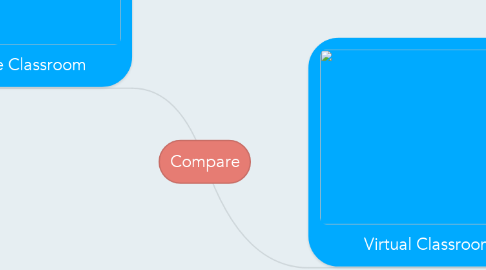
1. Face-2-Face Classroom
1.1. Faculty/Student Proximity
1.1.1. Trust / Emotional Support
1.1.2. Socialization
1.1.3. Interactivity
1.1.4. Logisitics
1.1.5. Expectations
1.1.6. Learning Pathways
1.1.7. Appropriate Feedback
1.1.8. Benefit of Proximity on Student Behavior
1.1.8.1. Focused Attention
1.1.8.2. Balanced Group Participation
1.1.8.3. Multitasking can be Limited
1.1.8.4. Student Monitoring (Reduction in Cheating)
1.1.9. Detriments of Proximity on Student Behavior
1.1.9.1. Class Disruptions Possible
1.1.9.2. Unproductive Student Interactions / Socializations
1.1.9.3. Unbalanced Group Participation / Personality Conflicts
1.1.9.4. Non-Participation in Discussions / Monopolization of Discussions
1.1.10. Benefits of Proximity on Student Performance
1.1.10.1. Clear Communication of Learning Pathway
1.1.10.2. Discussions & Groups can be Kept on Task
1.1.10.3. Students Benefit From Faculty Thought Processes
1.1.11. Detriments of Proximity on Student Performance
1.1.11.1. Forced Presence May Lead to Boredom
1.1.11.2. Presence may Limit Participation of Anxious or Shy Student Populations
1.2. Fixed Time Frame
1.2.1. Logistitcs
1.2.2. Interactivity
1.2.3. focused time for activities
1.2.4. Benefits of Fixed Time Frame on Student Performance
1.2.4.1. Time Management for In-Class Activities is Assured (Lectures / Discussions / Presentations / Media)
1.2.4.2. Fixed Schedule Allows for Predictable Class Prep
1.2.4.3. Predictable Access to Instructor (Know when questions will be answered)
1.2.5. Detriments of Fixed Time Frame on Student Performance
1.2.5.1. Complex Work / Home Life Schedule may Impact Students Ability to Prepare for a Fixed Date Class
1.2.5.2. Potential for Information Saturation Without Possiblity of Escape - May Lead to Attendance Issues
1.2.5.3. Potential for Cognitive Load Issues
1.2.5.4. Boredom may Result in Missed Instructions / Deadlines (Logistical Issues) that May Affect Student Performance
1.3. Flexibility / Adaptability
1.3.1. Responsive Activities
1.3.2. Responsive Student Evaluations
1.3.3. Responsive Questioning at Important Moments
1.3.4. Responsive Group Activities
1.3.5. Benefits of Flexibility on Student Performance
1.3.5.1. Customized Explanations
1.3.5.2. Learning Pathway Customized to Individuals and Groups
1.3.5.3. Lecture Adjustments on the Fly
1.3.5.4. Improvised Interactions to Fit Current Class
1.3.6. Detriments of Flexibility on Student Performance
1.3.6.1. Potential for Lack of Clarity
1.3.6.2. Lack of Full Polish Created by Improvised Materials
2. Virtual Classroom
2.1. Limitations
2.1.1. No Fixed Time Frame
2.1.1.1. Logistics Disconnect
2.1.1.2. Student Managed Pace
2.1.1.3. Scheduling Conflict Amongst Students
2.1.1.4. Detriments of No Fixed Time on Student Performance
2.1.1.4.1. No Forced Absorption of Logistical Information
2.1.1.4.2. Student Must Manage Time When Moving Through Materials
2.1.1.5. Benefit of No Fixed Time on Student Performance
2.1.1.5.1. Students can Work Around Their Schedule
2.1.1.5.2. Students can Decide Which Content to Focus Their Study Time On
2.1.2. No Proximity
2.1.2.1. Social Isolation
2.1.2.2. Logistic Disconnect
2.1.2.3. Unclear Expectations
2.1.2.4. Unclear Learning Pathways
2.1.2.5. Benefit of No Proximity on Student Behavior
2.1.2.5.1. Equal Participation in Discussions Can be Achieved
2.1.2.5.2. Limits to Class Disruptions
2.1.2.5.3. Limits to Inappropriate Social Interactions
2.1.2.5.4. Monopolization of Discussions can be Avoided
2.1.2.6. Detriments of No Proximity on Student Behavior
2.1.2.6.1. Multitasking can Disrupt Student Attention
2.1.2.6.2. Unbalanced Group Participation / Personality Conflicts
2.1.2.6.3. Gauging Student Attention & Understanding can he a challenge
2.1.2.6.4. Lack of Student Monitoring can Lead to Cheating
2.2. Opportunities
2.2.1. Intentional / Planned Activities
2.2.1.1. Planned Student Support
2.2.1.2. Planned Faculty Presence
2.2.1.3. Planned Socialization - Student 2 Student & Student & Faculty
2.2.1.4. Planned Communication of Schedules / Policies / Live Events / Office Hours
2.2.1.5. Planned Communication fo Expectations
2.2.1.6. Learning Pathways Must be Clear & Planned
2.2.1.7. Feedback Needs to be Personnel & Appropriate
2.2.1.8. Planned Interactions / Discussions / Activities
2.2.1.9. Planned Group Activities
2.2.1.10. Detriments of Planning on Student Performance
2.2.1.10.1. Lack of Flexibility in Responding to Learning Issues
2.2.1.10.2. Material Cost & Prep Time Might Make Adjustments Difficult
2.2.1.11. Benefit of Planning on Student Performance
2.2.1.11.1. Stable Social Enviroment
2.2.1.11.2. Clear Understanding of Expectations / Evaluations
2.2.1.11.3. Clear and Easy to Follow Learning Pathways
2.2.2. Adaptability / Flexibility
2.2.2.1. Constant Contact Possible
2.2.2.1.1. Detriments of Constant Contact on Student Performance
2.2.2.1.2. Benefit of Constant Contact on Student Performance
